BURY ME DEEP, IN A METALLIC CASE (1852)
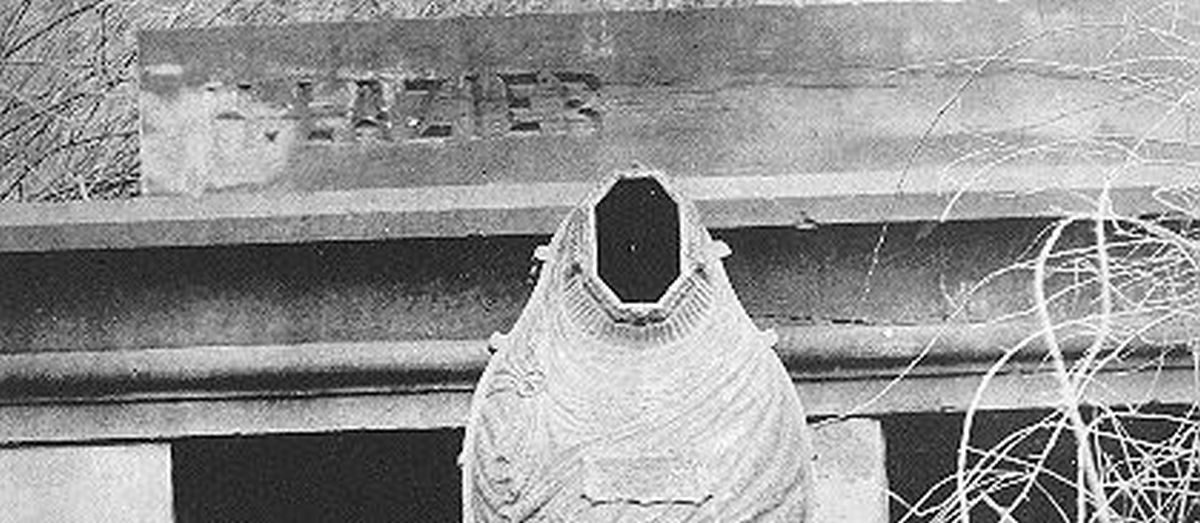
Brownstone Detectives investigates the history of our clients’ homes.
The story you are about to read was composed from research conducted in the course of one of those investigations.
Do you know the history of YOUR house?
********************************************************************************************************************************
In 1852, a Brooklyn Heights “sexton and general undertaker” by the name of F. A. Morrel, practicing at his “coffin-wareroom” at No. 57 Myrtle Avenue, was promoting to the Brooklyn public the latest design in funerary offerings – the Fisk Metallic Burial Case.
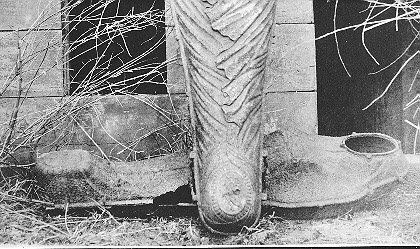
Originally designed as a vessel that would keep a dead body from decomposing if the individual had died far from home, the Fisk Metallic Burial Case would soon “take on a new life,” so to speak, for those who wanted their nearby loved ones to keep from rapidly decomposing, as well.
For this reason, many Fisk ads promoted their cases for the general preservation of the body – which was important to those whose burial case included a “viewing plate,” allowing for the living relatives to view the departed one’s face.
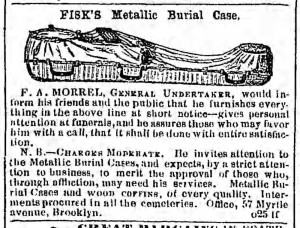
“From a coffin of this description the air may be exhausted so completely as entirely to prevent the decay of the contained body on principles well understood,” noted Fisk’s patent, “or, if preferred, the coffin may be filled with any gas or fluid having the property of preventing putrefaction.”
Another of the selling points of these cast iron caskets arose from a general fear of those ghouls and goblins that stalked the nation’s cemeteries and graveyards – body thieves and grave robbers. Once a body was sealed in this type casket, though, the case would be difficult to open, making it nearly impossible, also, to remove anything, including the body, from within.
This new offering was a coup for Morell, whose competition, notably S. N. Burrill, over at the corner of Montague and Court streets, although having been in the business some 25 years at the time, was continuing to simply bury people in cheap pine boxes.
“…THE BEST ARTICLE…FOR TRANSPORTING THE DEAD…”
Dolly Madison had been so impressed with the Fisk Metallic Burial Case that she had her husband, James Madison, disinterred, removed from his original casket, placed in a Fisk Metallic Burial Case, and then reburied. It is believed that Dolly, herself, left instruction to also be buried in a Fisk.
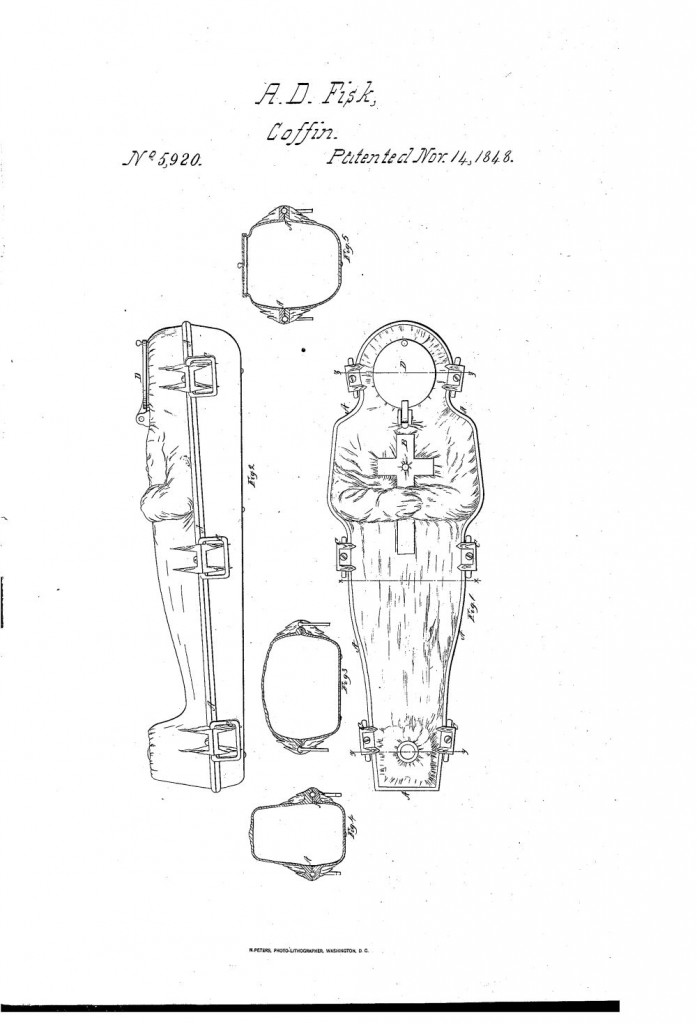
This was the beginning of an ad campaign that was designed to make the public comfortable with this new style casket – probably because it seemed so creepy – even at the time. Fisk would employ a number of well-know figures to announce their positive impressions to the public.
Most notably, in an April 1850 edition of the New York Tribune, a number of current national politicians gushed over the caskets, when they, in a letter to the Fisk (i.e., to the public), expounded upon just how impressed they were with the case that their recently deceased colleague, John C. Calhoun, had been transported in:
“Gentlemen: We witnessed the utility of your ornamental Patent metallic Burial Case used to convey the remains of the late Honorable John C. Calhoun to the Congressional Cemetery. It impressed us with the belief that it is the best article known to us for transporting the dead to their final resting place.”
The testimonial was signed by none other than Jefferson Davis, Henry Dodge, Henry Clay, Daniel Webster, and Lewis Cass.
Of these politicians, at least one of these men, Henry Clay, was later buried in a Fisk. It is likely that, in return for their promotion of Fisk’s product, these men were either remunerated or they were given free burials in one of Fisk’s Metallic Burial Case – or both.
…BUT BACK TO MORREL…
Morrel practiced at his 57 Myrtle Avenue location from 1852 through 1855, about the time that the Fisk cases were first being mass advertised throughout the country. After the latter date, though, he does not advertise these coffins – or himself as an undertaker – after which his building appears in public records as a drug store.
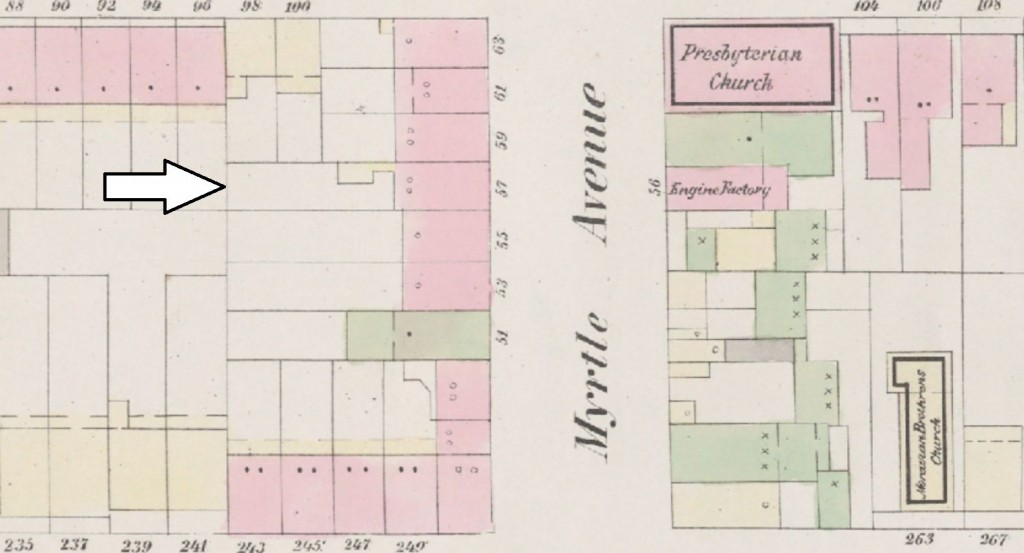
It is possible, thus, that Morrel was a local distributor for this Long Island produced brand of casket and that his sole reason for setting up shop in Brooklyn in 1852 was to promote Fisk’s cast iron caskets in this city.
Fisk’s company eventually went out of business, whereupon the idea of a cast iron casket was….shall we say….buried (for good).
(For a creepy tour of a recovered Fisk Metallic Burial Case, along with some great – and creepy – pictures, read Atlas Obscura’s wonderful story, “The Cast Iron Coffin That Was Too Creepy Even For The Victorians”.)
(To hear an interesting interview with Jon N. Austin, the Executive Director of the Museum of Funeral Customs in Springfield, Illinois, as he discusses their iron coffin display in their museum, as well as the Fisk Metallic Burial Case in the collection, click HERE. Austin also discusses 19th century funerary customs and the age-old fear and fallacy of being buried alive.)
———————————————————————————————————————–
 Brownstone Detectives is an historic property research agency. Our mission is to document and save the histories of our clients’ homes. From our research, we produce our celebrated House History Books and House History Reports. Contact us today to begin discovering the history of your home.
Brownstone Detectives is an historic property research agency. Our mission is to document and save the histories of our clients’ homes. From our research, we produce our celebrated House History Books and House History Reports. Contact us today to begin discovering the history of your home.